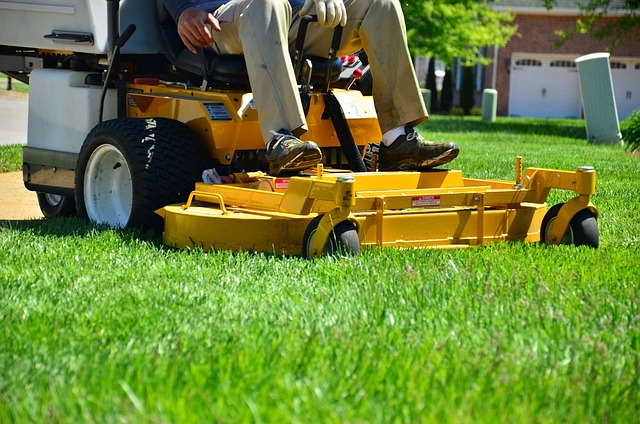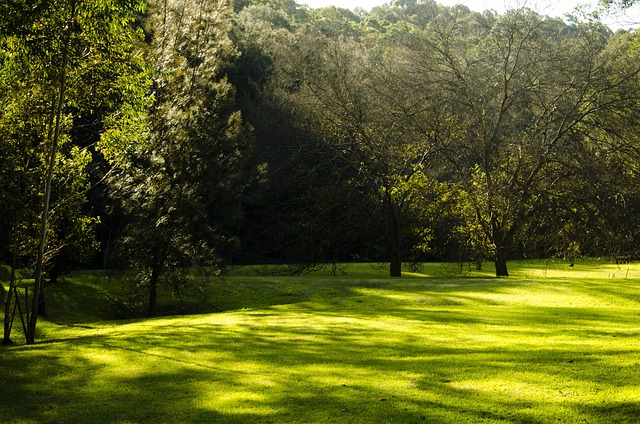Lawn Care and Landscaping involves two key practices: mulching and edging. Mulching with organic materials improves soil structure, conserves moisture, regulates temp, facilitates nutrient cycling, and enriches fertility. Inorganic mulch suppresses weeds and preserves moisture. Edging trims transition zones for enhanced aesthetics, prevents weed encroachment, and simplifies lawn maintenance by enabling precise application of fertilizers and pesticides. Regular applications of both practices maintain a lush, well-defined lawn.
Transform your lawn from ordinary to extraordinary with the power of mulching and edging. This essential practice goes beyond aesthetics, offering numerous benefits for lawn health and maintenance. In this comprehensive guide, we’ll explore the science behind mulching, different types suitable for various needs, and effective edging techniques. Discover how these simple yet impactful strategies can enhance your lawn’s vibrancy, structure, and overall landscape appeal through expert tips on best practices. Elevate your lawn care and landscaping game today!
- Understanding Mulching: Benefits and Types for Lawn Health
- Edging Techniques: Enhancing Lawn Aesthetics and Maintenance
- Best Practices for Effective Mulching and Edging Routines
Understanding Mulching: Benefits and Types for Lawn Health

Mulching is a crucial aspect of lawn care and landscaping, offering numerous benefits for your yard’s overall health. By adding organic material, such as wood chips or straw, to the top layer of soil around plants and trees, mulching enriches the soil structure, conserves moisture, and regulates temperature. This natural process promotes nutrient cycling, ensuring your lawn gets a consistent supply of essential elements for robust growth.
Different types of mulch cater to various needs. Organic mulches, derived from living materials, are popular choices due to their ability to decompose, enhancing soil fertility over time. On the other hand, inorganic mulches like stones or gravel provide a long-lasting solution, preventing weed growth and preserving moisture without breaking down. In lawn care, understanding these variations allows for tailored applications, ensuring your landscaping efforts not only enhance aesthetics but also contribute to a healthier, more vibrant lawn.
Edging Techniques: Enhancing Lawn Aesthetics and Maintenance

Edging, a often overlooked yet powerful tool in lawn care and landscaping, plays a pivotal role in enhancing your yard’s overall aesthetics. It involves trimming the transition zone between walkways, driveways, and your lush green lawn, creating clean lines that give your property a polished look. This meticulous process not only improves visual appeal but also contributes to better lawn maintenance. By defining these boundaries, you prevent weeds from encroaching onto your manicured grass, reducing the need for constant weeding. Furthermore, edging allows for more precise application of fertilizers and pesticides, ensuring these vital treatments go exactly where they’re needed.
For those seeking to elevate their lawn care game, various edging techniques are available. From manual edgers to power-driven tools, each offers unique advantages. Manual methods, though requiring more effort, provide precise control and are ideal for smaller areas. Power tools, on the other hand, offer speed and efficiency, making them suitable for larger properties. Incorporating regular edging into your lawn care routine will not only keep your yard looking sharp but also make maintenance tasks like mowing easier by preventing grass from accumulating along edges.
Best Practices for Effective Mulching and Edging Routines

To maintain a lush and well-defined lawn, adopting effective mulching and edging practices is paramount in lawn care and landscaping. Start by selecting the right mulch type for your grass variety; organic mulches like wood chips or straw not only enrich the soil but also suppress weeds naturally. Apply mulch evenly across your lawn, ensuring a layer of 2-4 inches to prevent moisture evaporation and provide nutrients.
Edging is another crucial aspect that defines your lawn’s aesthetic appeal. Use high-quality edging tools to cleanly separate your grass from sidewalks, driveways, and flower beds. Regularly sharpen these tools to maintain precision cuts, which not only gives your lawn a polished look but also allows for better water penetration and air circulation at the soil level, promoting healthier grass growth.
Mulching and edging are essential practices in lawn care and landscaping, offering both aesthetic and functional benefits. By understanding the different types of mulches and edge techniques, you can enhance your lawn’s health, improve curb appeal, and streamline maintenance routines. Incorporating these strategies into your regular lawn care regimen will lead to a lush, well-maintained outdoor space that becomes the envy of your neighborhood.
